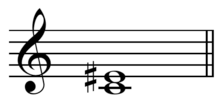Augmentation (music)
In Western music and music theory, the word augmentation (from Late Latin augmentare, to increase) has three distinct meanings. Augmentation is a compositional device where a melody, theme or motif is presented in longer note-values than were previously used. Augmentation is also the term for the proportional lengthening of the value of individual note-shapes in older notation by coloration, by use of a sign of proportion, or by a notational symbol such as the modern dot. A major or perfect interval that is widened by a chromatic semitone is an augmented interval, and the process may be called augmentation.
Augmentation in composition
A melody or series of notes is augmented if the lengths of the notes are prolonged; augmentation is thus the opposite of diminution, where note values are shortened. A melody originally consisting of four quavers (eighth notes) for example, is augmented if it later appears with four crotchets (quarter notes) instead. This technique is often used in contrapuntal music, as in the "canon by augmentation" ("per augmentationem"), in which the notes in the following voice or voices are longer than those in the leading voice, usually twice the original length.[1] The music of Johann Sebastian Bach provides examples of this application. Other ratios of augmentation, such as 1:3 (tripled note values) and 1:4 (quadrupled note values), are also possible.[2]
A motif is also augmented through expanding its duration.[3]
Augmentation may also be found in later, non-contrapuntal pieces, such as the Pastoral Symphony (Symphony No. 6) of Beethoven, where the melodic figure heard twice in the last ten bars of the "Storm" movement ("Die Sturm") is an augmented and transposed version of the motif first heard in the second violins in the third bar,[4] or the development sections of sonata form movements, particularly in the symphonies of Brahms and Bruckner.[2]
Augmentation in notation

Augmentation of intervals

An interval is augmented if it is widened by a chromatic semitone. Thus an augmented fifth, for example, is a chromatic semitone wider than the perfect fifth. The standard abbreviations for augmented intervals are AX, such that an augmented third = A3.[5]
| Augmented unison | Augmented second | Augmented third | Augmented fourth | Augmented fifth | Augmented sixth | Augmented seventh |
|---|---|---|---|---|---|---|
| |
 |
 |
 |
 |
 |
 |
| | | | | | | |
A good example of this can be seen in the left hand part of Chopin's famous E minor prelude Op. 28, No. 4. Many of the chord sequences change with the top or bottom note augmenting or diminishing the next chord as the music progresses.
 Augmented triad on C |
 Augmented dominant seventh chord on C |

An augmented chord is one which contains an augmented interval, almost invariably the 5th of the chord. An augmented triad is a major triad whose fifth has been raised by a chromatic semitone; it is the principal harmony of the whole tone scale.
See also
Sources
- ↑ Jeppesen, Knud. Counterpoint: The Polyphonic Vocal Style of the Sixteenth Century. trans. Glen Haydon. New York: Dover Publications. 1992. ISBN 978-0-486-27036-4. p. 235
- 1 2 "Augmentation and diminution" in the Harvard Dictionary of Music, 2nd ed. rev. and enlarged (1969). Willi Apel, ed. Cambridge, Mass.: The Belknap Press of Harvard University Press
- ↑ Forte, Allen (1979/1962). Tonal Harmony in Concept & Practice, p.391. Third edition. ISBN 0-03-020756-8.
- ↑ Bullivant, Roger. "Augmentation (ii)". Grove Music Online. Oxford Music Online. Retrieved August 2011. Check date values in:
|access-date=(help) (subscription needed) - ↑ Benward & Saker (2003). Music: In Theory and Practice, Vol. I, p.54. ISBN 978-0-07-294262-0.